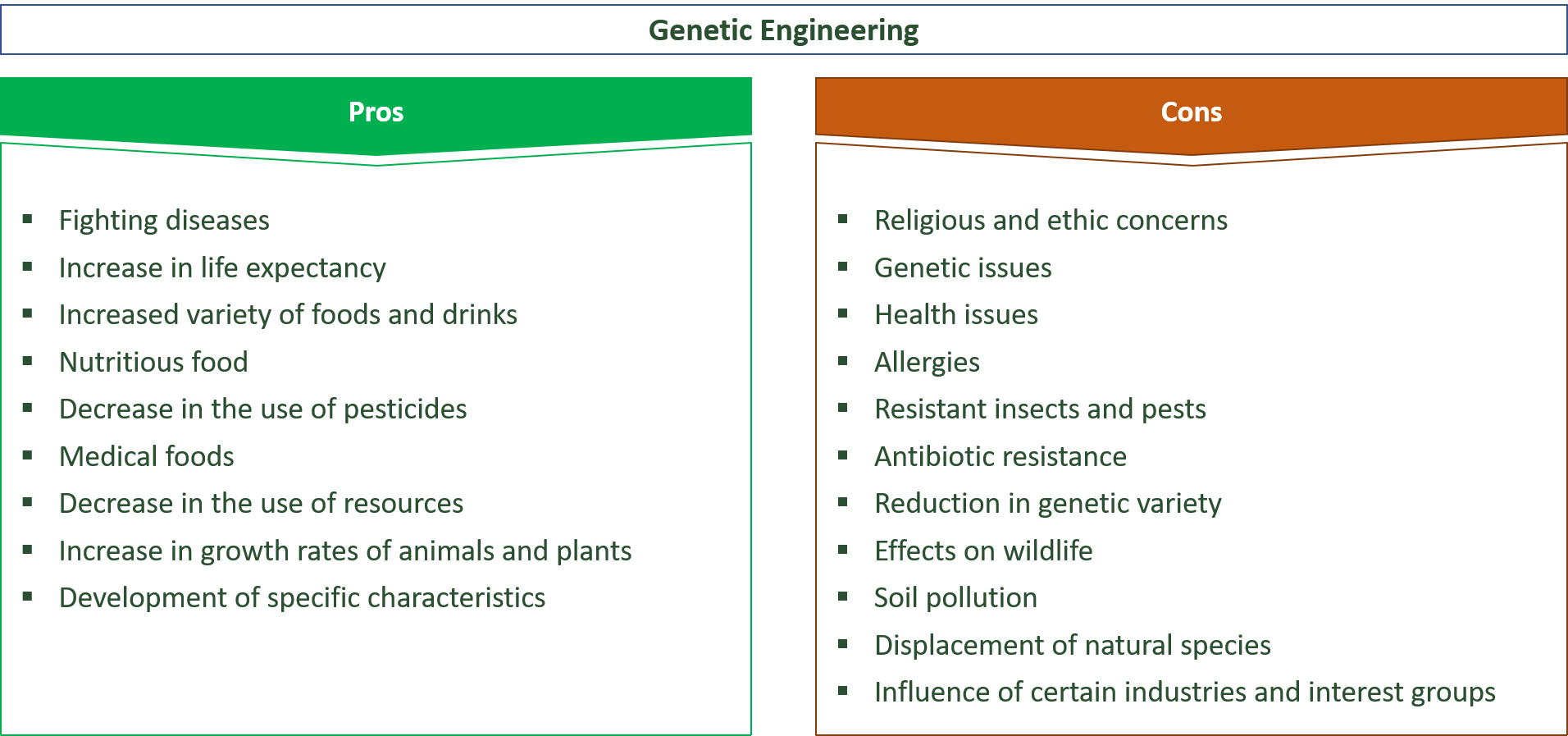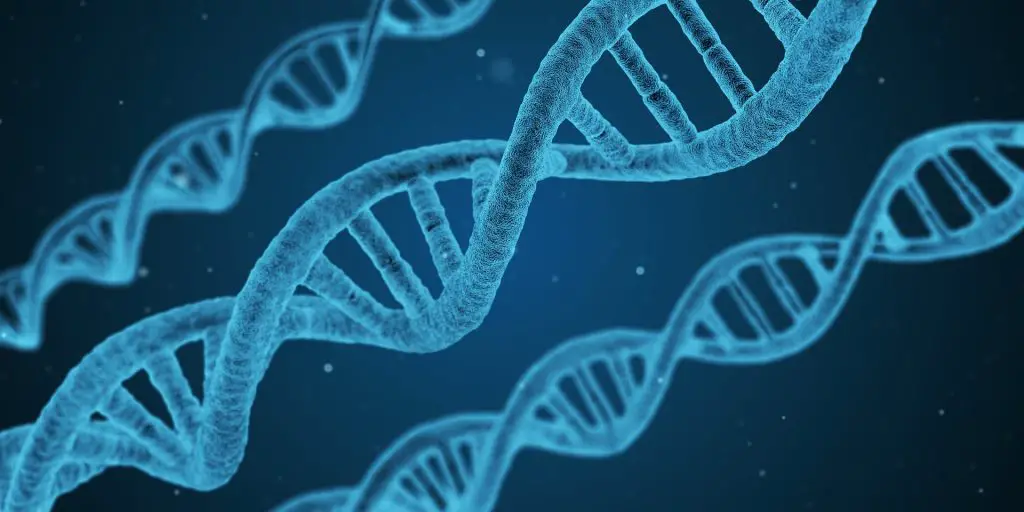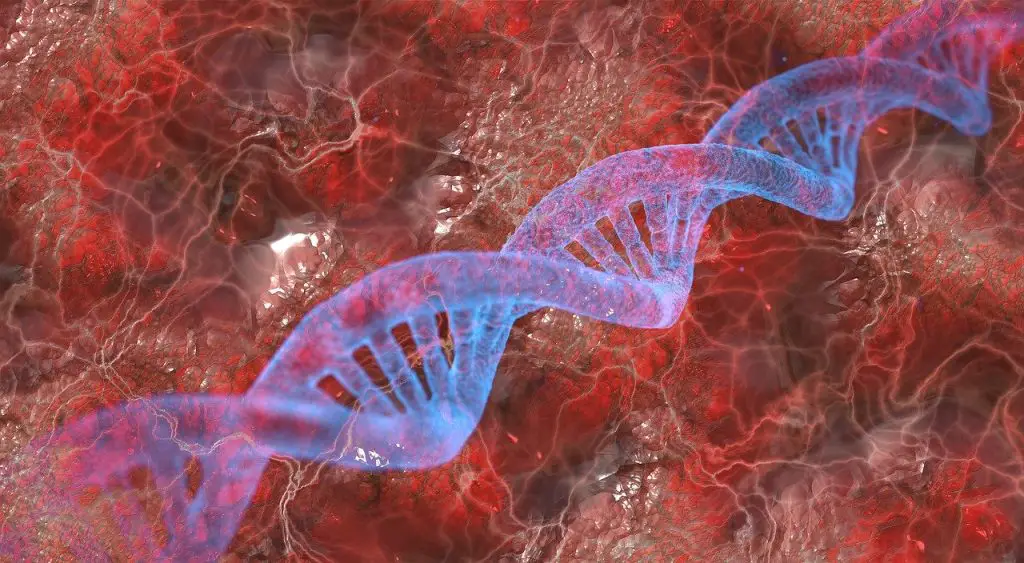“I think the ethics and morals of genetic engineering are very complicated. It intrigues me.”
Roger Spottiswoode
The Pros and Cons of Genetic Engineering

Genetic engineering can be defined as manipulation of an organism’s genes with the help of biotechnology.
The first official genetic manipulation happened in 1972 by Paul Berg when he combined the DNA from a monkey virus with the lambda virus.
Genetic engineering is a very controversial topic in our society.
There are many pros and cons regarding this topic.
In the following, the advantages as wells as the downsides of genetic manipulation are examined.
Audio Lesson
Contents
How does Genetic Engineering Work?
In order to create a genetically modified organism, scientists first have to choose what gene they want to insert into the organism.
With the help of genetic screens, potential genes can be tested with the goal of finding the best candidates.
When a suitable gene has been determined, the next step is to isolate it.
The cell which contains the gene has to be opened and the DNA has to be purified.
After isolating the gene, it is ligated into a plasmid which is inserted into a bacterium.
Thus, whenever the bacterium divides, the plasmid is also replicated.
This leads to a vast number of copies of this gene.
Before inserting the gene into the target organism, it has to be combined with other genetic elements including a terminator and promoter region which end and initiate the transcription.
In the final step, the genetic material is inserted into a host genome.
After that, the genetic engineering process is finished.
Fields of Application of Genetic Engineering
Research
Genetic engineering is often used by scientists to improve their understanding of how genetics actually work and how they affect our talents and our decisions.
From these findings, scientists can provide insights for medical purposes and thus increase the probability of curing serious diseases in the future.
Medicine
There are many important areas in the field of medicine in which genetic manipulation could contribute to better treatment of diseases.
This also includes the invention of more effective drugs with fewer side effects.
Moreover, model animals can be genetically modified in the hope to get new insights on how these modifications would work on humans.
For this purpose, using mice in order to examine the effects of genetic manipulation on obesity, cancer, heart diseases and other serious conditions is common practice in nowadays scientific work.
Agriculture
Genetic engineering is also used in the field of agriculture in order to increase yields and also make plants more resistant to pests.
Moreover, even genetic experiments on livestock have been performed in the past.
Apart from the use for consumption, plants have also been genetically modified for medical purposes.
By changing the gene structure of plants, scientists want to examine if they could produce new drugs that can cure diseases more effectively.
Industry
Genetic manipulation is also a field of interest for industrial purposes.
Since through genetic engineering processes, all kinds of properties of animals and plants can be modified, this also comes down to a potential increase in revenue for firms if they are able to optimize the gene structure for their purposes.
An example of this is the use of genetically modified bacteria for making biofuels.
Regulation
The rules and regulations for genetic engineering vary significantly across different countries.
However, there is some consensus on the level of danger genetic modification poses to humanity.
For example, the majority of scientists claim that there is no greater risk to human health from genetically modified crops compared to conventional food.
However, before making this genetically modified food available for public consumption, it has to be tested extensively in order to exclude any possibility of danger.
Moreover, some groups like Greenpeace or the World Wildlife Fund claim that genetically modified food should be tested more rigorously before releasing it for public consumption.

Advantages of Genetic Engineering
- Fighting diseases
- Increase in life expectancy
- Increased variety of foods and drinks
- Nutritious food
- Decrease in the use of pesticides
- Medical foods
- Decrease in the use of resources
- Increase in growth rates of animals and plants
- Development of specific characteristics
Fighting diseases
There are some severe diseases that we will likely never be able to fight if we do not use genetic engineering.
From only small manipulations of genes, it is expected that we can fight a significant number of deadly diseases.
Moreover, even for unborn babies, there could be genetic diseases detected.
The most prominent example of this kind of genetic disease is Down syndrome.
If our scientists get quite advanced, it is likely that we would be able to cure all genetic diseases, even that of unborn children.
Abortions because of the diagnosis of genetic diseases would no longer be necessary since we could ensure the babies’ health through genetic manipulation.
Increase in life expectancy
Since we can fight many diseases with genetic engineering, the overall life expectancy of people is likely to increase since the dangers of death due to these diseases decreases.
Moreover, if we are able to further improve our knowledge regarding genetic modification, diseases could be treated more effectively.
Especially in poor countries where some diseases can cause the death of many people, also the development of genetically modified plants for medical use could be a great measure in order to mitigate the issue.
We could also fight diseases which usually cause death for old people and thus prolong their lives.
Moreover, we can increase their life quality since old people do not have to suffer from these diseases anymore.
Thus, genetic engineering may lead to an increase in average life expectancy.
Increased variety of foods and drinks
With the help of genetic manipulation, we could increase the variety of foods and drinks for our daily consumption.
Moreover, we could further improve the crop yields since we could create sorts of plants that are resistant to all kinds of pests.
Thus, we could supply enough food to all people worldwide and fight famine in an effective way.
Nutritious food
Additionally, with the help of genetic engineering, it may be possible to create more nutritious food.
This would be especially beneficial in countries where people suffer from vitamin deficiencies.
If we are able to increase the level of these vitamins in crops or other foods, we could help people to overcome their vitamin deficiency.
Decrease in the use of pesticides
If we are able to modify the genetics in a way that they naturally become resistant against pests, we will no longer have to use harmful chemical pesticides.
Thus, genetic engineering may also lead to a reduction in the use of pesticides.
Medical foods
With the help of genetic engineering, we may also be able to create certain medical foods which may also replace some of the common injections.
Medical foods may also help to prevent certain diseases.
Therefore, genetic engineering could also lead to an improvement in medical standards.
Decrease in the use of resources
Through genetic engineering, it would be possible to create plant species that need less water than the plant species currently used in agriculture.
By replacing the natural species with genetically modified ones, farmers could save plenty of water.
This would be especially useful in regions where water shortage is a serious problem.
Water shortage will be a quite big issue in the future due to global warming.
If the average temperature increases, water scarcity is likely to also increase.
Thus, with the help of genetic modification, water can be saved and the problem of water shortages may be mitigated to a certain extent.
Increase in growth rates of animals and plants
We may also be able to increase the speed of growth of plants and animals.
By doing so, we could produce more food in a given period of time.
This may quite important since our world population is growing and therefore the demand for food is increasing.
Development of specific characteristics
Through genetic modification, we may also be able to strengthen specific characteristics of plants.
This may include that plants are better able to adapt to the global warming problem or that they may become more resistant to changes in their natural conditions.

Problems of Genetic Engineering
- Religious and ethic concerns
- Genetic issues
- Health issues
- Allergies
- Resistant insects and pests
- Antibiotic resistance
- Reduction in genetic variety
- Effects on wildlife
- Soil pollution
- Displacement of natural species
- Influence of certain industries and interest groups
Religious and ethic concerns
Many followers of religions are strictly against genetic engineering since they think „playing god“ should not be a task performed by humans.
There are also ethical concerns if genetic manipulation should become a valid instrument for changing the course of our lives.
There is also the argument that diseases are a natural phenomenon and that they have a role in nature since they persisted over a quite long time horizon of evolution.
Moreover, there are many scientists who believe that the creation of „designer babies“ could not be in the interest of humanity.
If perfected, parents could choose the eye color, hair color or even the sex of the baby.
This could lead to an optimization contest in our society which could also have vastly negative effects if pushed too far.
Genetic issues
Genetic manipulation can also cause genetic problems if we do not handle it in a proper way.
Since science is still at an early stage in the understanding of genetics, manipulations of genes may even do more harm than good at our current state of genetic understanding.
Errors could even lead to the development of new diseases or to miscarriages.
Health issues
Genetic engineering also poses a risk to human health.
For example, genetically modified food may lead to long-term health issues.
There is just not enough reliable data yet on how harmful genetic engineering really is in the long term.
Thus, it may pose serious health effects, some of them currently even unknown to scientists.
Allergies
Genetic engineering may also lead to the development of allergies against certain food items.
Since the DNA-structure is altered in the genetic modification process, food that has former been uncritical for people could now cause allergic reactions.
Resistant insects and pests
Genetic engineering is also used to modify plants.
Specifically, some plant species have been developed which include their own pesticide which can protect them from animals and insects.
In this way, scientists hope to be able to increase crop yields.
However, this altering of genetic code in plants can lead to a resistance of certain insects to the pesticide.
This may pose big problems to the agricultural system since if insects or other pests become resistant against toxins, they are harder to fight.
Thus, in the short run, altering genetic material in plants may have its advantages.
However, in the long run, there may be severe issues when it comes to resistance of pest strains.
Antibiotic resistance
Some researchers are afraid that genetic engineering may also lead to resistance against antibiotics for humans.
This may lead to serious problems since the treatment of diseases with antibiotics will not be effective anymore.
Reduction in genetic variety
Genetic engineering would also lead to a reduction in genetic diversity.
Since the process of gene manipulation would be quite expensive, only rich people would be able to afford it.
Thus, this would likely lead to human behavior which favors being rich over all other things in order to be able to afford genetic manipulation.
As a consequence, the variety of human behavior would be reduced.
Effects on wildlife
Since genetically modified plants often contain own pesticides, they can be quite harmful to animals that are consuming these kinds of plants.
Animals can suffer severe diseases from these pesticides and even die.
This problem is especially severe for butterflies and other insects which usually rely on certain plants in their near surroundings.
If the natural versions of plants are replaced by genetically modified plants containing pesticides, these insects are likely to suffer from severe health conditions.
Soil pollution
Researchers found that residues of genetically modified plants persist on the soil of fields for many months.
Thus, the activity of microbes is adversely affected which can lead to a loss in fertility of the soil.
Displacement of natural species
If genetically modified plants are more resistant against pests, chances are that they will displace local natural plant species in the long run.
This also contributes to a reduction in genetic variety and can cause the issues related to this phenomenon.
Influence of certain industries and interest groups
Genetic engineering is an area that can be quite profitable for some firms.
However, it is also quite an expensive field of study.
There are some big companies that have huge control over the seed market and thus also have a big influence on political decisions regarding the admission of genetically engineered plants for agricultural purposes.
Thus, even if there may be dangers from these admissions, companies may still get permission to sell the genetically modified seeds since they may have high influence on political decision makers.

Examples for Genetic Engineering
- Golden rice
- Mouse-ear cress
- Onions
- Soybean oil
- Carrots
- Abiotic stress
- Bananas
- Purple tomatoes
- Arctic apple
Golden rice
Golden rice, unlike any other sort of rice, also contains provitamin A.
It is estimated that a lack of this vitamin causes up to 500.000 cases of blindness across children each year.
Moreover, around one million people even die from a lack of this vitamin.
Thus, the introduction of this gene manipulated golden rice could mitigate this problem.
Mouse-ear cress
Genes from the mouse-ear cress are studied extensively since they help scientists to understand the nature of a variety of plant characteristics concerning photosynthetic activity, droughts, growth speed and many more.
After finding the genes related to different characteristics of the mouse-ear cress, they can be used to modify the genes of cultivated species in order to improve their yields and resistance.
Onions
Even just a small modifications in the genes of onions have led to significant effects.
On the one hand, the modified onion doesn’t make people cry anymore when they cut it.
On the other hand, the concentration of healthy compounds like sulfur-containing substances has been increased.
Soybean oil
There have been attempts to lower the concentration of saturated fatty acids in soy oil.
Moreover, there are also companies trying to increase the level of omega-3 fatty acids of their oils.
Carrots
In order to fight the osteoporosis problem, genetically modified carrots with a higher concentration of organically bound calcium have been produced.
Studies have shown that humans were able to absorb 42% more calcium from the modified carrots than from normal carrots.
Abiotic stress
There have been several experiments of genetic modification in order to fight abiotic stress with the purpose of increasing frost resistance, drought resistance or the resistance against flooded fields.
Bananas
Bananas are an important source of calories for many people.
However, they are vulnerable to new kinds of diseases.
Thus, a pepper gene has been inserted in bananas in order to make them more resistant.
Purple tomatoes
Transferring a gene from a decorative plant into a tomato not only changed the color of the tomato from red to purple, it also enabled the tomato to produce anthocyanin, which prevented mice from getting cancer.
Arctic apple
When cutting an apple and leaving it untouched for a while, it usually turns brown.
There have been attempts from industries to create a sort of apples called „Arctic apple“, which will no longer turn brown after cutting.

Top 10 Genetic Engineering Pros & Cons – Summary List
| Genetic Engineering Pros | Genetic Engineering Cons |
|---|---|
| Genetic engineering can help fight diseases | Humans should not play god |
| Can be used to increase crop yields | Ethical concerns |
| Genetic engineering can reduce global hunger | Religious concerns |
| May increase the variety of foods | Safety of genetic engineering has not been proven yet |
| Can make foods healthier | May damage genetics in the long run |
| Genetic engineering can help to invent new medications | Genetic engineering may lead to antibiotic resistence |
| Plants may grow quicker | Adverse effects on wildlife are possible |
| More efficient use of natural resources | Displacement of species |
| Can make the use of pesticides obsolete | Resistant insects and pests |
| Increase in overall life expectancy | Genetic engineering may lead to new allergies |
Conclusion
Genetic engineering is a quite controversial topic in our society.
It has many advantages and fields of application, but can also have detrimental effects on humans as well as on the whole ecological system.
There are also many religious and ethical concerns against the use of gene manipulation.
Thus, as humans, we have to make difficult decisions in the future on whether we want to „play god“ in order to be able to fight deadly diseases or if we do not want to take the risk.
Sources
http://www.fao.org/3/Y5160E/y5160e10.htm#P3_1651The
http://www.fao.org/3/y4955e/y4955e06.htm
https://en.wikipedia.org/wiki/Genetic_engineering

About the author
My name is Andreas and my mission is to educate people of all ages about our environmental problems and how everyone can make a contribution to mitigate these issues.
As I went to university and got my Master’s degree in Economics, I did plenty of research in the field of Development Economics.
After finishing university, I traveled around the world. From this time on, I wanted to make a contribution to ensure a livable future for the next generations in every part of our beautiful planet.
Wanna make a contribution to save our environment? Share it!
